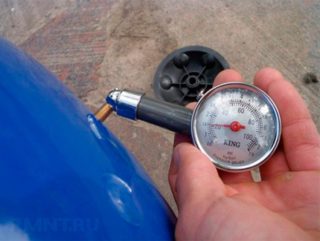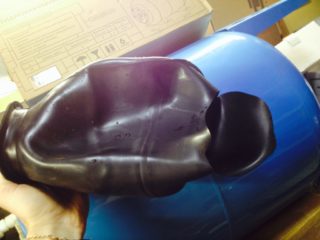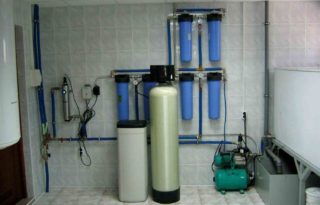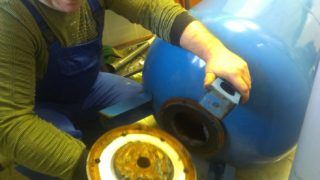The main purpose of the accumulator is to reduce the number of starts and stops of the pump installed in the autonomous water supply system of a private house. Also, its function is to hold a certain volume of water, which is required during the repair of the pumping station or the lack of power supply. Over time, the hydraulic tank wears out and malfunctions. There are few reasons for the malfunctions.
Accumulator problems

The most common malfunction is a decrease in pressure inside the water supply network. There is only one reason - the pressure between the rubber membrane and the steel walls of the accumulator has dropped. At the factory, nitrogen is pumped into the tank under a pressure of 1.5 atm. It creates a pressure inside the water supply network by pressure on the membrane, into which water is pumped from a well or well.
The nitrogen pressure decreases for various reasons, but more often due to the weak holding capacity of the nipple. It is not difficult to solve this problem yourself. For this, a car pressure gauge is used, which checks the pressure by installing it on the nipple. The latter is located on the opposite side from the inlet pipe of the hydraulic tank.
- Remove the plastic nipple cover.
- Install a pressure gauge, check the pressure inside the container.
- If the parameter is underestimated, air is pumped through the same nipple with a conventional automobile pump to the desired value.
- Close the nipple with a cap.
Usually this operation is carried out on an operating device, therefore there are certain requirements for the procedure. To do this, turn off the pump, open one of the consumers (usually the closest to the accumulator) and drain all the water.
Even if after this the pressure in the accumulator used quickly drops, the reason must be looked for in another. Most often these are smudges at the joints of the plumbing system. Therefore, it is necessary first of all to investigate the entire water supply system. Usually, they check the joints between pipes, joints with fittings, with valves, with filters for various purposes, with consumers and other products installed in the plumbing system of a private house. If smudges have been identified, they must be eliminated.
There are two more reasons why the accumulator does not hold the required pressure. This also applies to reducing the nitrogen pressure inside the tank.
- Over time, areas of leaks appear at the junction of the flange-nipple connection. Gas leaks through them. To solve this problem, it is necessary to unscrew the nipple, remove the old flange and replace it with a new one. Spare parts and parts from hydraulic tanks are sold in all hardware stores.
- The same goes for the joint between the flange and the pear-shaped rubber diaphragm. Sometimes this problem is solved by simply tightening the fastening bolts (there are six of them in the tank design).

Sometimes in the accumulator, the membrane simply breaks due to wear. To replace the rubber bulb, you need to disassemble the device:
- the pump is disconnected from the power supply;
- one of the consumers opens, water is drained from the water supply network;
- flexible hoses connecting the accumulator with the water supply are unscrewed;
- unscrew the six bolts connecting the flange with the membrane with a wrench;
- the flange is removed, the pear is pulled out;
- the container is washed and dried;
- a new membrane is installed;
- a flange is mounted, which is tightened with fastening bolts;
- from the side of the nipple, air is pumped into the tank using a car pump up to a pressure of 1.5 atm .;
- the accumulator is connected with flexible hoses to the water supply;
- the pressure switch is configured to turn on and off the pump unit, taking into account the passport pressure of the hydraulic tank.
This repair process can take several hours. The service center will do it in half an hour. But since the procedures are simple, you can do them yourself.
To find out exactly whether the rubber membrane has torn or not, one experiment is necessary. You need to take a screwdriver or a match, which you need to press on the nipple. If water poured out, it means that the container is completely filled due to a ruptured membrane.
No water enters the hydraulic tank

This reason for the inoperative state of the hydraulic tank is common. It's all about the degree of pollution of the water that is pumped from a well or borehole. Filters are installed in front of the pump and the entrance to the house, which periodically clog up. This leads to the fact that the accumulator does not collect water.
The pump has the least problems with the first filter. It rarely clogs, because it has a mesh structure with large cells. Its task is not to let stones and debris inside the pumping unit.
Filters installed inside the house in the water treatment system often get clogged. The dirtier the water, the faster the blockage occurs. Usually they replace cartridges with new ones. In the passports of these products, the standards for the service life of the devices are established. They should be taken as the basis for prevention.
Another reason why the accumulators are not filled with water is a sharp drop in the voltage in the network. The pump from this does not work correctly. Its characteristics are falling, such as pressure and productivity. The drop in pressure is the drop in pressure of the water stream itself. It cannot withstand the nitrogen pressure inside the accumulator. The gas pumped into the reservoir simply does not allow the liquid to penetrate the rubber bulb.
The problem is solved by purchasing a step-up transformer, which is installed between the connection point and the pumping station.
The third reason is the airing of the water main. This phenomenon is often encountered in autonomous networks, especially if a surface pump is installed in them. In some area, an air lock forms, which stands still and does not allow water to move further.
For this, a tee is usually mounted on the suction circuit with the installation of a drain cock or valve. When such a situation arises, you just need to open the tap and drain the water along with the air.
The reasons for airborne airing can be different situations:
- deformation of the suction hose, the appearance of through cracks or holes on it, in this case it is better to replace the hose with a new one;
- lowering the water level in the well or well, due to which air is drawn into the suction pipe, the problem is easily solved - you need to lower the hose lower.
The reasons for not filling the accumulator tank are complex in terms of their correction. This is the repair of a tank or water main. The difficulty lies in the fact that it is always possible to quickly find the source of the problem.
Accumulator maintenance

In order for the plumbing system to work, taking into account the responsibilities assigned to it, it is necessary to properly maintain it. In this regard, special attention is paid to the hydraulic tank. Preventive actions:
- check once every six months for compliance with the nitrogen pressure inside the container;
- check the membrane for leaks once a year;
- once a month inspect the tank for dents, rust and other external defects;
- once every six months, check the operation of the pressure switch: whether the pump turns on and off correctly, whether it corresponds to the specified parameters.
If the house is preserved for the winter, the water supply must be prepared.The main task of the owner is to drain the water from the accumulator and pipes. It is recommended to check all the elements in the spring. In the hydraulic tank, first of all, the gas pressure is checked, and then it is filled and checked for leaks.









But still, why are there possible breaks or cracks in the outer (metal case) of the accumulator? The house burst on July 4, 2020, i.e. not from frost, worked less than 4 years.